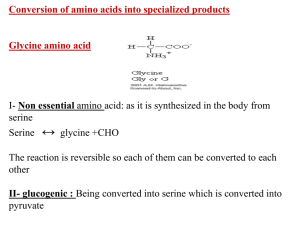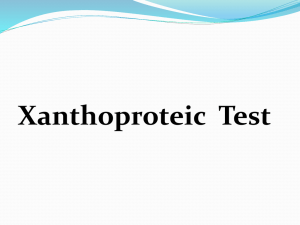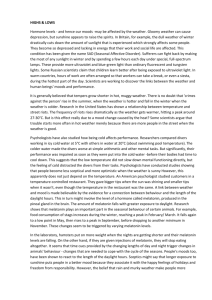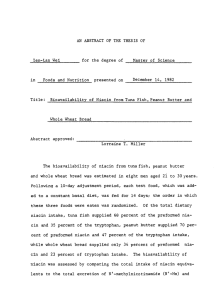Protein mteabolism
advertisement
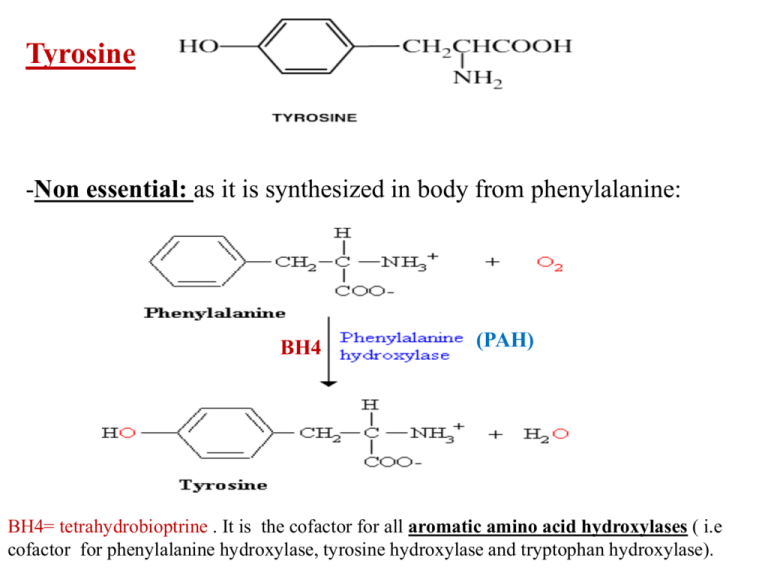
Tyrosine -Non essential: as it is synthesized in body from phenylalanine: BH4 (PAH) BH4= tetrahydrobioptrine . It is the cofactor for all aromatic amino acid hydroxylases ( i.e cofactor for phenylalanine hydroxylase, tyrosine hydroxylase and tryptophan hydroxylase). - Tyrosine is mixed glucogenic and ketogenic as it gives fumarate ( so, glucogenic) and acetoacetate (so ketogenic) - NB: Phenyl alanine is essential amino acid, not synthesized in body. - Phenyl alanine is mixed glucogenic and ketogenic as it is converted into tyrosine which is mixed. Functions of tyrosine: tyrosine enter in the synthesis of: 1- catecholamines 2- melanin pigment 3- thyroid hormones 1- Catecholamines: dopamine, epinephrine and nor epinephrine Epinephrine and nor epinephrine are secreted from adrenal medulla in response to fear, stress, anger, low blood glucose and hypotension. They stimulate degradation of glycogen and TAG (stimlate glycogenolysis and lipolysis). Synthesis of catecholamines also called tyrosinase 2-Synthesis of melanin: Melanin is aromatic quinone. It is black or brown pigment present in skin, hair and eyes. Its function is to protect underlying cells from the harmful effects of sun light ( UV radiation). dopaquinone Albinism: Genetic disease due to genetic deficiency of tyrosinase enzyme and lack of melanin synthesis. This leads to hypopigmentation of skin, hair and eyes making the albino are sensitive to sun light (photophobia), increasing the incidence of skin burns and cancer. 3- Synthesis of thyroid hormones (T3 and T4): - Tyrosine +I2 gives monoiodotyrosine (MIT) and diiodotyrosine (DIT) - one MIT + one DIT gives T3 - 2 DIT gives T4 (structures not required) Tryptophan amino acid - Essential amino acid - Both glucogenic and ketogenic (gives pyruvate and Acetyl CoA). Functions: 1- Synthesis of serotonin (5-hydroxy tryptamine) in gut, CNS, platelets (BH4) THB= BH4 (tetrahydrobioptrine) AAAO= aromatic amino acid decarboxylase Serotonin is a neurotransmitter, vasoconstrictor. Regulate mood and sleeping. Its deficiency lead to depression. It is used as antidepressant Research found that fruits (like dates, banana and papaya), turkey, peanuts, almonds, green leaves increase the synthesis of serotonin Serotonin is popularly thought to be a contributor to feelings of well-being and happiness. Approximately 90% of the human body's total serotonin is located in the intestine, where it is used to regulate intestinal movements. The remainder is synthesized in neurons of the CNS, where it has various functions. These include the regulation of mood, appetite, and sleep. Serotonin also has some cognitive functions, including memory and learning. Increasing serotonin is the mechanism of action of several classes of antidepressants. 2- Synthesis of melatonin: Melatonin is N-acetyl 5-methoxy tryptamine - ↓↓ 1) N-acetylation 2) O-methylation Synthesis and secretion of melatonin is regulated by dark/light cycle. Production of melatonin by the pineal gland in brain is inhibited by light and stimulated by darkness. For this reason melatonin has been called "the hormone of darkness. - Melatonin is sleep-inducing molecule -So ingestion of food rich in tryptophan leads to sleepiness. It is powerful antioxidant It has important role in protecting skin from damaging effect of UV radiation: 3- Synthesis of nicotinic acid (niacin) - Niacin (vitamin B3) is a member of vitamin B complex. -Coenzyme NAD and NADP are derived from niacin. NAD (to remember the structure, not required) - Deficiency of niacin leads to pellagra (dermatitis, diarrhea and Dementia). Insomnia and high sensitivity to sunlight. - Pellagra occurs in case of deficiency of dietary tryptophan which converted into niacin - Pellagra occurs in areas where people eat mainly maize (corn, the only grain low in digestible niacin) - 4-Indole and skatole: - are volatile oils derived from tryptophan metabolism in normal conditions and give stool its characteristic odor. skatole
